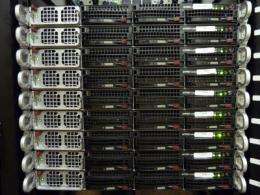Virginia Tech to build new supercomputer

Two million dollars is coming to Virginia Tech to create HokieSpeed, a versatile new supercomputing instrument for accelerating and transforming discovery and innovation across a myriad of disciplines.
Wu Feng, associate professor of computer science as well as electrical and computer engineering and principal investigator on the grant, along with Khidir Hilu, professor of biological sciences, and Scott King, professor of geosciences, all at Virginia Tech, successfully applied for the $2 million grant through the National Science Foundation's Major Instrumentation Program to invent and build "HokieSpeed."
Feng, who joined Virginia Tech in 2006, is an expert in efficient computing systems. He is the founder of the Green500 List, a ranking of the most energy-efficient supercomputers in the world, and considered to be a complementary listing to the Top500 List of supercomputers (http://www.cs.vt.edu/node/5219?nid=5219). He also serves as the faculty co-director for the NSF Center on High Performance Reconfigurable Computing (CHREC), an NSF Industry/University Cooperative Research Center (I/UCRC).
Virginia Tech became a key player in the field of high-end computing in 2003, when it designed and built System X, when the machine was ranked as the fastest academic supercomputer in the world (November, 2003 TOP500 List). Srindhi Varadarajan, associate professor of computer science, was the chief architect of System X (http://www.cs.vt.edu/facilities/systemx).
Feng described HokieSpeed as a new heterogeneous supercomputing instrument based on a combination of central processing units (CPUs) and graphical processing units (GPUs). In terms of raw performance, he noted that HokieSpeed is expected to deliver 35 times better peak performance, 70 times better peak power efficiency, and 14 times better peak space efficiency than System X.
"HokieSpeed is expected to catalyze new approaches for conducting research via the synergistic amalgamation of heterogeneous supercomputing and cyber-enabled tools to enhance ease of use. In particular, it will give end users the ability to perform in-situ visualization for rapid visual information synthesis and analysis. It will also control their level of immersion in the discovery process - from being completely immersed, making real-time intuitive decisions via a large-scale gigapixel display, to observing the instrument automatically collect, organize, and analyze data in support of visual analytics. A large set of Virginia Tech researchers from across the university will be actively involved in research using HokieSpeed," Feng said.
The expectations for HokieSpeed come from the researchers' plan to have each compute node of the supercomputer consist of both CPUs and GPUs. Since the 1960s, the CPU has served as the brains in computing instruments. Recent trends, however, have exposed the CPU as a "jack of all (computing) trades, master of none," Feng said, "thus giving rise to heterogeneous computing instruments with multiple types of brains that include both CPUs and GPUs.
"This transformative instrument will empower faculty, students, and staff across disciplines to tackle problems previously viewed as intractable or that required heroic efforts and significant domain-specific expertise to solve," Feng said.
As an example, Feng cited his leadership of a team of more than 20 interdisciplinary researchers from eight institutions around the world in 2007. They developed software cybertool instruments to integrate a set of distributed supercomputers, totaling 12,000 plus CPUs, to enable the discovery of missing genes in 699 microbial genomes. Originally thought to be computationally infeasible, his team completed the task in 10 weeks.
Virginia Tech's Office of the Vice President for Information Technology and the Office of the Vice President for Research provided key enabling cost sharing support for this project.
The three-year NSF grant is from American Recovery and Reinvestment Act funds.
Provided by Virginia Tech
















